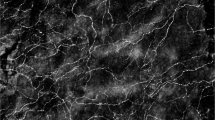Summary
The functional role of cytokeratin intermediate filaments in the translocation of asymmetric membrane plaques between cytoplasm and surface of apical urothelial cells was investigated during contraction and expansion of rat urinary bladders. A stereological investigation of electron micrographs provided estimations of surface area, volume, and number of discoidal vesicles and infoldings per unit volume of urothelial apical cell cytoplasm. Contracted and distended bladders incubated in 0.01 M sodium bicarbonate were compared to identical preparations experimentally incubated in 5 mM thioglycolic acid. The latter reagent disrupts the intermediate filament network by reducing sulfhydryl bridges. Densities of discoidal vesicles in cells contracted after incubation in thioglycolate were similar to density estimations in cells expanded under control conditions. Similarly, densities of vesicles in cells expanded after exposure to thioglycolate were comparable in number to those in normally contracted cells. Thus, membrane translocation to and from the luminal surface was blocked by thioglycolate treatment. The lack of normal membrane transfer at the luminal surface induces apical cells exposed to experimental conditions to undergo extraordinary adjustments in response to external pressures of bladder contraction and distension. During contraction, the apical-intermediate cell interface unfolded while the luminal surface ballooned out into the lumen. In distended bladders, large intercellular spaces formed between apical cells along their lateral margins. The results support a model published earlier implicating the filament network as a critical mediator of membrane translocation.
Similar content being viewed by others
References
Bonneville MA, Chlapowski FJ (1981) Characterization of intermediate-type filaments in urothelium. J Cell Biol 91:234a
Burgess DR, Broschat KO, Hayden JM (1987) Tropomyosin distinguishes between the two actin-binding sites of villin and affects binding properties of other brush border proteins. J Cell Biol 104:29–40
Chlapowski FJ, Bonneville MA, Staehelin LA (1972) Lumenal plasma membrane of the urinary bladder. II. Isolation and structure of membrane components. J Cell Biol 53:92–104
Franke WW, Schiller DL, Moll R, Winter S, Schmid E, Engelbrecht I (1981a) Diversity of cytokeratins. Differentiation specific expression of cytokeratin polypeptides in epithelial cells and tissues. J Mol Biol 153:933–959
Franke WW, Winter S, Grund C, Schmid E, Schiller DL, Jarasch E-D (1981b) Isolation and characterization of desmosome-associated tonofilaments from rat intestinal brush border. J Cell Biol 90:116–127
Grey P (1973) Encyclopedia of Microscopy and Microtechnique. Van Nostrand Reinhold, New York, p 568
Hayat MA (1981) Principles and Techniques of Electron Microscopy. Biological Applications University Park Press, Baltimore, Vol 1: pp 327–340
Hicks RM (1965) The fine structure of the transitional epithelium of rat ureter. J Cell Biol 26:25–48
Hicks RM (1966a) The function of the Golgi complex in transitional epithelium. Synthesis of the thick cell membrane. J Cell Biol 30:623–643
Hicks RM (1966b) The permeability of rat transitional epithelium. Keratinization and the barrier to water. J Cell Biol 28:21–31
Hull BE, Staehelin LA (1979) The terminal web, a reevaluation of its structure and function. J Cell Biol 81:67–82
Karnovsky MJ (1965) A formaldehyede-glutaraldehyde fixative of high osmolarity for use in electron microscopy. J Cell Biol 27:137
Keller GA, Pazirandeh M, Krisans S (1986) 3-hydroxy-3-methylglutaryl coenzyme A reductase localization in rat liver peroxisomes and microsomes on control and cholestyraminetreated animals: quantitative biochemical and immunoelectron microscopical analyses. J Cell Biol 103:875–886
Koss LG (1969) The asymmetric unit membranes of the epithelium of the urinary bladder of the rat. An electron microscopic study of a mechanism of epithelial maturation and function. Lab Invest 21:154–168
Leeson CR (1962) Histology, histochemistry and electron microscopy of the transitional epithelium of the rat urinary bladder in response to induced physiological changes. Acta Anat 48:297–315
Minsky BD, Chlapowski FJ (1978) Morphometric analysis of the translocation of lumenal membrane between cytoplasm and cell surface of transitional epithelial cells during the expansion-contraction cycles of mammalian urinary bladder. J Cell Biol 77:685–697
Moll R, Franke WW, Volc-Platzer B, Krepler R (1982) Different keratin polypeptides in epidermis and other epithelia of human skin: a specific cytokeratin of molecular weight 46000 in epithelia of the pilosebaceous tract and basal cell epithelimas. J Cell Biol 95:285–295
Porter KR, Kenyon K, Badenhausen S (1965) Origin of discoidal vesicles in cells of transitional epithelium. Anat Rec 151:401 a
Porter KR, Kenyon K, Badenhausen S (1967) Specializations of the unit membrane. Protoplasma 63:262–274
Reynolds ES (1963) The use of lead citrate at high pH as an electron opaque stain in electron microscopy. J Cell Biol 17:208
Sarikas SN, Chlapowski FJ (1986) Effect of ATP inhibitors on the translocation of luminal membrane between cytoplasm and cell surface of transitional epithelial cells during the expansioncontraction cycle of the rat urinary bladder. Cell Tissue Res 246:109–117
Staehelin LA, Chlapowski FJ, Bonneville MA (1972) Lumenal plasma membrane of the urinary bladder. I. Three-dimensional reconstruction from freeze-etch images. J Cell Biol 53:73–91
Tash JS, Hidaka H, Means AR (1986) Axokinin phosphorylation by cAMP-dependent protein kinase is sufficient for activation of sperm flagellar motility. J Cell Biol 103:649–655
Walker BE (1960) Electron microscopic observations on transitional epithelium of the mouse urinary bladder. J Ultrastruct Res 3:345–361
Weibel ER (1979) Stereological Methods. Vol I: Practical Methods for Biological Morphometry. Academic Press, New York, pp 26–45
Weibel ER, Kistler GS, Scherle WF (1966) Practical Stereological methods for morphometric cytology. J Cell Biol 30:23–28
Author information
Authors and Affiliations
Rights and permissions
About this article
Cite this article
Sarikas, S.N., Chlapowski, F.J. The effect of thioglycolate on intermediate filaments and membrane translocation in rat urothelium during the expansion-contraction cycle. Cell Tissue Res. 258, 393–401 (1989). https://doi.org/10.1007/BF00239460
Accepted:
Issue Date:
DOI: https://doi.org/10.1007/BF00239460




